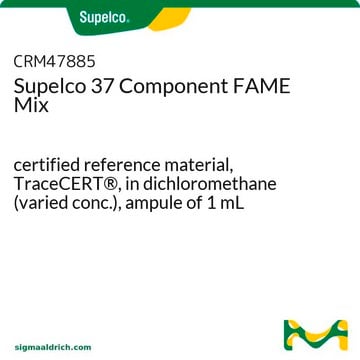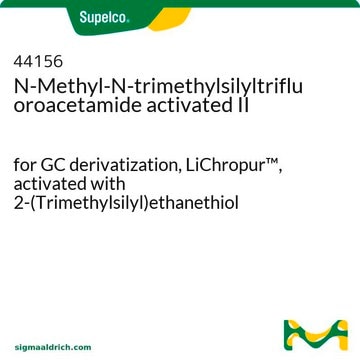Products may be shipped at a different temperature than the recommended long-term storage temperature. If the product quality is sensitive to short-term exposure to conditions other than the recommended long-term storage, it will be shipped on wet or dry-ice. If the product quality is NOT affected by short-term exposure to conditions other than the recommended long-term storage, it will be shipped at ambient temperature. As shipping routes are configured for minimum transit times, shipping at ambient temperature helps control shipping costs for our customers. For more information, please refer to the Storage and Transport Conditions document: https://www.sigmaaldrich.com/deepweb/assets/sigmaaldrich/marketing/global/documents/316/622/storage-transport-conditions-mk.pdf
69479
N-Methyl-N-(trimethylsilyl)trifluoroacetamide
for GC derivatization, LiChropur™, ≥98.5%
Synonym(s):
N-Trimethylsilyl-N-methyl trifluoroacetamide, MSTFA
Select a Size
Select a Size
About This Item
Recommended Products
grade
for GC derivatization
Quality Level
vapor density
>1 (vs air)
vapor pressure
8.8 mmHg ( 27 °C)
Assay
≥98.5% (GC)
≥98.5%
form
liquid
quality
LiChropur™
reaction suitability
reagent type: derivatization reagent
reaction type: Silylations
technique(s)
gas chromatography (GC): suitable
refractive index
n20/D 1.38 (lit.)
n20/D 1.380
bp
130-132 °C (lit.)
density
1.075 g/mL at 25 °C (lit.)
storage temp.
2-8°C
SMILES string
CN(C(=O)C(F)(F)F)[Si](C)(C)C
InChI
1S/C6H12F3NOSi/c1-10(12(2,3)4)5(11)6(7,8)9/h1-4H3
InChI key
MSPCIZMDDUQPGJ-UHFFFAOYSA-N
Looking for similar products? Visit Product Comparison Guide
General description
Application
Other Notes
Legal Information
related product
Signal Word
Warning
Hazard Statements
Precautionary Statements
Hazard Classifications
Eye Irrit. 2 - Flam. Liq. 3 - Skin Irrit. 2 - STOT SE 3
Target Organs
Respiratory system
Storage Class Code
3 - Flammable liquids
WGK
WGK 3
Flash Point(F)
77.0 °F - closed cup
Flash Point(C)
25 °C - closed cup
Personal Protective Equipment
Choose from one of the most recent versions:
Already Own This Product?
Find documentation for the products that you have recently purchased in the Document Library.
Customers Also Viewed
Articles
Development and validation of a fatty acid methyl esterification method, using methanolic HCl reagent, for FAME analysis by GC of vegetable oils and fats.
Development and validation of a fatty acid methyl esterification method, using methanolic HCl reagent, for FAME analysis by GC of vegetable oils and fats.
Development and validation of a fatty acid methyl esterification method, using methanolic HCl reagent, for FAME analysis by GC of vegetable oils and fats.
Development and validation of a fatty acid methyl esterification method, using methanolic HCl reagent, for FAME analysis by GC of vegetable oils and fats.
Protocols
Example displays how MSTFA/MSTFA-d9 derivatization of amphetamine provides valuable information in mass spectra and chromatograms using SLB-5ms GC column.
-
How is shipping temperature determined? And how is it related to the product storage temperature?
1 answer-
Helpful?
-
-
How can I determine the shelf life / expiration / retest date of this product?
1 answer-
If this product has an expiration or retest date, it will be shown on the Certificate of Analysis (COA, CofA). If there is no retest or expiration date listed on the product's COA, we do not have suitable stability data to determine a shelf life. For these products, the only date on the COA will be the release date; a retest, expiration, or use-by-date will not be displayed.
For all products, we recommend handling per defined conditions as printed in our product literature and website product descriptions. We recommend that products should be routinely inspected by customers to ensure they perform as expected.
For products without retest or expiration dates, our standard warranty of 1 year from the date of shipment is applicable.
For more information, please refer to the Product Dating Information document: https://www.sigmaaldrich.com/deepweb/assets/sigmaaldrich/marketing/global/documents/449/386/product-dating-information-mk.pdfHelpful?
-
-
What is the packaging of the product N-Methyl-N-(trimethylsilyl)trifluoroacetamide, code: 69479-10X1ML, bottle, ampoule, blister or other??
1 answer-
The 1ML size is packaged in a 5mL amber glass vial with a Schwarz-type septum cap. The vials are then placed in a 10-place overpack box with dividers to protect each vial. Please see the image below of this cap type.
Helpful?
-
Active Filters
Our team of scientists has experience in all areas of research including Life Science, Material Science, Chemical Synthesis, Chromatography, Analytical and many others.
Contact Technical Service









